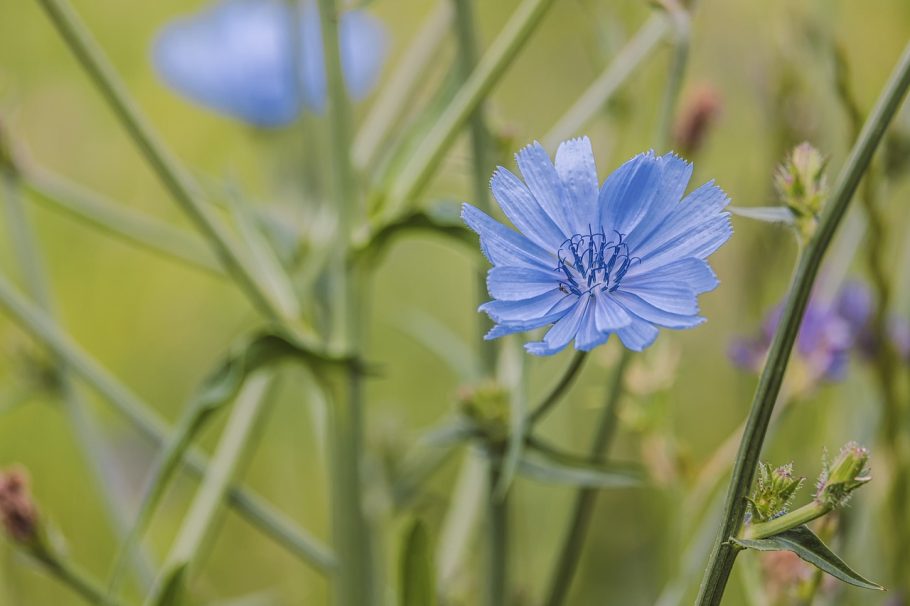The history of bachelor buttons dates back to ancient times, where it was believed that the flower was once worn by the Greek goddess Athena during battle and the term “cornflower” was derived from the fact that the flower was often found growing in fields of corn. Throughout history, bachelor buttons have been used for a variety of purposes, from medicinal remedies to culinary creations.
The flower has also been incorporated into various cultures, such as in Germany where it symbolized the country’s national color, and in folklore where it represented loyalty and fidelity. Today, bachelor buttons continue to hold a special place in many gardens, adding both beauty and meaning to any landscape design.
- Bachelor buttons have been used for medicinal purposes, such as for treating eye inflammation and other ailments.
- They have also been used in cooking, with the petals often added to salads or used as a natural food dye.
- Bachelor buttons represent purity, celibacy, and charm.
The History of Bachelor Buttons
Bachelor buttons, also known as cornflowers, have a rich history that has spanned many cultures throughout history. In mythology, it is said that the flower was first worn by the Greek goddess Flora. It was later adopted by the Romans, who used it to decorate the wreaths of victorious generals.
In medieval times, bachelor buttons were popularly used as a medicinal herb, believed to hold healing properties for ailments such as eye infections and digestive issues. They were also used as a symbol of love, with young men giving the vibrant blue flowers to their sweethearts as a sign of devotion.
During the Renaissance, the flowers were woven into garlands and used to decorate elaborate tapestries and other decorative items. In the Victorian era, bachelor buttons were considered a symbol of remembrance and were often included in funeral arrangements.
Today, bachelor buttons continue to be a popular garden staple, adding a pop of color and vibrancy to any landscaping project. With their long and rich history, it’s not hard to understand why they have remained a beloved flower for centuries.
Best Growing Conditions
When it comes to growing bachelor buttons, it’s important to understand the best conditions for optimal growth and bloom. These wildflowers thrive in well-draining soils with a neutral pH level. They prefer full sunlight, but can also tolerate partial shade. In terms of temperature, bachelor buttons do best in cooler weather and can even tolerate frost.
To ensure the best growing conditions for bachelor buttons, it’s important to prepare your soil before planting. Mix in organic matter, such as compost, to improve soil structure and fertility. Avoid overwatering, as bachelor buttons prefer drier soil.
When it comes to maintenance, deadheading old blooms can encourage new growth and prolong flowering. Fertilizing with a balanced fertilizer can also promote healthy growth and vibrant color.
Overall, bachelor buttons are easy-to-grow wildflowers that can add charm and beauty to any garden project with minimal effort. With the right growing conditions and maintenance, you can enjoy their striking color and delicate texture all season long.
Planting and Maintenance Tips
When planting and maintaining bachelor buttons, there are a few key factors to keep in mind to ensure optimal growth and bloom. Here are some tips:
- Sowing seeds: Bachelor buttons are easy to grow from seed and should be planted directly in the garden in early spring. Be sure to sow the seeds in well-drained soil and keep them moist until they germinate.
- Watering: Bachelor buttons prefer moist soil but can be susceptible to root rot if the soil is too wet. Water deeply once a week, or more often during hot, dry weather.
- Fertilizing: Bachelor buttons don’t require much fertilizer, but a light application of compost or a balanced fertilizer in early spring can help boost growth and bloom. Avoid over-fertilizing, as this can lead to leggy plants with few blooms.
- Troubleshooting: Bachelor buttons are generally pest and disease-resistant, but they can be susceptible to powdery mildew in humid conditions. To prevent this, space plants properly to allow for good air circulation, and avoid overhead watering.
By following these simple tips, you can enjoy a beautiful display of bachelor buttons in your garden all season long!
Uses for Bachelor Buttons
Bachelor buttons, also known as cornflowers, are a versatile flower that have been widely used for various purposes throughout history. From their vivid blue color to their striking shape, these flowers have caught the eye of many garden enthusiasts and herbalists alike.
One of the most notable uses of bachelor buttons is their medicinal value. It is believed that the flowers possess anti-inflammatory properties that can help alleviate a wide range of ailments, from headaches to digestive issues. Some even use it as a natural remedy for eye infections and as a diuretic.
When it comes to culinary purposes, bachelor buttons have been used in a variety of ways. The flowers can be used to add a pop of color and flavor to salads, desserts, and even soups. The petals, which have a slightly sweet taste, can also be used to make tea and infused syrups.
Aside from their medicinal and culinary uses, bachelor buttons have also been used as a decorative element. Their vibrant blue petals can be used to add a splash of color to floral arrangements and bouquets, and their unique shape makes them great for adding texture to any garden design.
Whether you’re a gardener, herbalist, or simply someone who appreciates the beauty of nature, bachelor buttons are a versatile and easy-to-grow flower that shouldn’t be overlooked.
Arrangements and Bouquets
Bachelor buttons, also known as cornflowers, add a touch of elegance and vibrancy to any floral arrangement. They can be paired with other flowers or can stand alone in an arrangement. Creating a stunning floral arrangement or bouquet with bachelor buttons is simple and easy.
First, choose a color scheme. Bachelor buttons come in a range of colors, including blue, pink, white, and purple. Decide on the color or colors that best complement the occasion or setting.
Next, select a vase or container that is appropriate for the size of the arrangement. Fill the vase with water and floral preservative.
When designing the arrangement, start with the larger flowers first and then add the smaller ones for a balanced look. Bachelor buttons make a great addition to bouquets with their delicate petals. Combine them with other wildflowers, such as Queen Anne’s Lace or Black-eyed Susan, for a rustic look.
Don’t forget about greenery! Bachelor buttons pair well with greenery such as baby’s breath or eucalyptus.
Once the arrangement is complete, trim the stems to the desired length and place it in the vase. Change the water every few days to keep the flowers fresh.
In summary, creating stunning floral arrangements and bouquets with bachelor buttons is easy and fun. With its delicate petals and vibrant colors, it is sure to add a touch of elegance to any occasion.
Companion Planting
If you’re looking to incorporate bachelor buttons into your garden, it’s important to know what plants pair well with them to enhance the growing experience for all plants involved. Bachelor buttons actually make great companion plants for a variety of vegetables and herbs, including tomatoes, cucumbers, peppers, and thyme.
One benefit of planting bachelor buttons alongside these other plants is that they attract beneficial insects like bees, butterflies, and ladybugs, which can help with pollination and pest control. Additionally, the bright blue and purple blooms of bachelor buttons provide a beautiful pop of color among the greens and reds of the vegetables.
When it comes to incorporating companion plants, it’s important to make sure they have similar growing requirements and aren’t competing for resources like sunlight and water. Bachelor buttons prefer full sun or partial shade and well-draining soil, so choose companion plants that thrive under similar conditions.
Overall, incorporating bachelor buttons into your garden can not only add a unique and vibrant touch to your landscaping, but also benefit the overall health and growth of your other plants. So consider planting some of these easy-to-grow wildflowers alongside your vegetables and herbs this season.
Types of Bachelor Buttons
Bachelor buttons, also known as cornflowers, are a popular and easy-to-grow wildflower that can add color and vibrance to any garden or landscaping project. There are many different varieties of bachelor buttons available on the market, each with its own unique features and growing trends.
When it comes to color options, bachelor buttons are available in shades of blue, pink, white, and purple, with some varieties even featuring bi-colored blooms. Some of the most popular types of bachelor buttons include the classic blue bachelor button, the double-flowered ‘Blue Boy,’ and the ‘Black Ball’ variety with its deep, dark purple blooms.
In terms of growing trends, bachelor buttons are a favorite among gardeners because they are easy to care for and can thrive in various conditions. They are drought-resistant and can grow well in full sun or partial shade, making them a versatile option for any garden or landscaping project.
If you’re interested in growing bachelor buttons, it’s important to research the specific variety you choose to ensure you provide the optimal growing conditions. Whether you’re looking for a specific color or growing trend, there is a bachelor button variety out there for every gardener’s needs.
Hybrids and Unique Breedings
Hybridization and unique breeding practices have allowed for an expansion of color and growth varieties when it comes to bachelor buttons, making them an even more attractive addition to any garden or landscaping project. Breeders have experimented with crossbreeding different types of bachelor buttons to create new and unique color patterns, including shades of pink, purple and red. Some hybrids have also been bred to have bigger or more abundant blooms, adding even more beauty to the garden.
One popular hybrid is the double-flowered bachelor button, which features multiple rows of petals creating a more dramatic and delicate appearance. Another hybrid is the ‘Black Magic’ bachelor button, which boasts deep burgundy or almost black blooms. These unique color varieties can add a pop of intense color to any garden or bouquet.
In addition to unique colors, hybridization has also allowed for bachelor buttons to grow in a wider range of conditions. There are now varieties that are more heat-tolerant, cold-tolerant, or drought-tolerant, allowing gardeners in all types of climates to enjoy the beauty of these wildflowers. Overall, the advancement in hybridization and breeding practices has expanded the possibilities for bachelor buttons, making them a versatile and easy-to-grow addition to any outdoor space.





